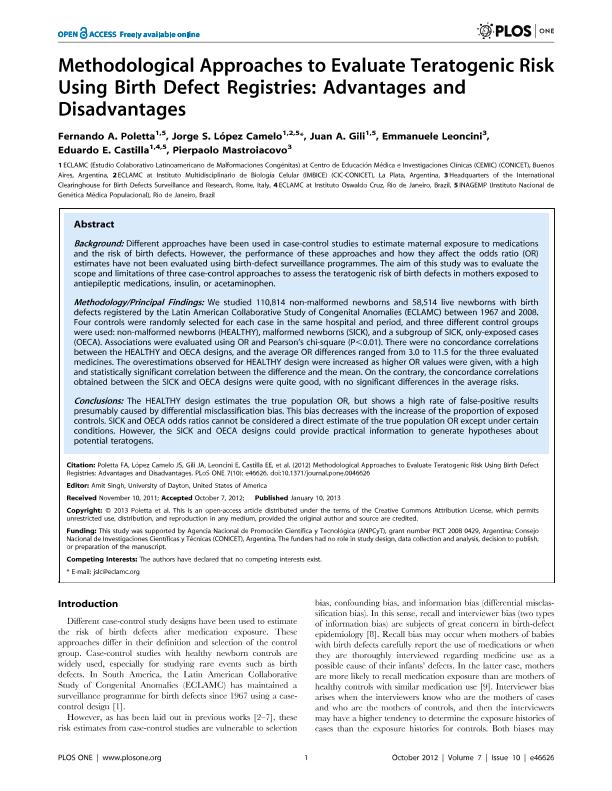Mostrar el registro sencillo del ítem
dc.contributor.author
Poletta, Fernando Adrián

dc.contributor.author
López Camelo, Jorge Santiago

dc.contributor.author
Gili, Juan Antonio

dc.contributor.author
Leoncini, Emmanuele
dc.contributor.author
Castilla, Eduardo Enrique

dc.contributor.author
Mastroiacovo, Pierpaolo
dc.date.available
2019-02-25T19:42:43Z
dc.date.issued
2012-10
dc.identifier.citation
Poletta, Fernando Adrián; López Camelo, Jorge Santiago; Gili, Juan Antonio; Leoncini, Emmanuele; Castilla, Eduardo Enrique; et al.; Methodological Approaches to Evaluate Teratogenic Risk Using Birth Defect Registries: Advantages and Disadvantages; Public Library of Science; Plos One; 7; 10; 10-2012; 1-11; e46626
dc.identifier.issn
1932-6203
dc.identifier.uri
http://hdl.handle.net/11336/70811
dc.description.abstract
Background: Different approaches have been used in case-control studies to estimate maternal exposure to medications and the risk of birth defects. However, the performance of these approaches and how they affect the odds ratio (OR) estimates have not been evaluated using birth-defect surveillance programmes. The aim of this study was to evaluate the scope and limitations of three case-control approaches to assess the teratogenic risk of birth defects in mothers exposed to antiepileptic medications, insulin, or acetaminophen. Methodology/Principal Findings: We studied 110,814 non-malformed newborns and 58,514 live newborns with birth defects registered by the Latin American Collaborative Study of Congenital Anomalies (ECLAMC) between 1967 and 2008. Four controls were randomly selected for each case in the same hospital and period, and three different control groups were used: non-malformed newborns (HEALTHY), malformed newborns (SICK), and a subgroup of SICK, only-exposed cases (OECA). Associations were evaluated using OR and Pearson's chi-square (P<0.01). There were no concordance correlations between the HEALTHY and OECA designs, and the average OR differences ranged from 3.0 to 11.5 for the three evaluated medicines. The overestimations observed for HEALTHY design were increased as higher OR values were given, with a high and statistically significant correlation between the difference and the mean. On the contrary, the concordance correlations obtained between the SICK and OECA designs were quite good, with no significant differences in the average risks. Conclusions: The HEALTHY design estimates the true population OR, but shows a high rate of false-positive results presumably caused by differential misclassification bias. This bias decreases with the increase of the proportion of exposed controls. SICK and OECA odds ratios cannot be considered a direct estimate of the true population OR except under certain conditions. However, the SICK and OECA designs could provide practical information to generate hypotheses about potential teratogens.
dc.format
application/pdf
dc.language.iso
eng
dc.publisher
Public Library of Science

dc.rights
info:eu-repo/semantics/openAccess
dc.rights.uri
https://creativecommons.org/licenses/by-nc-sa/2.5/ar/
dc.subject
Teratogenic Risk
dc.subject
Birth Defect
dc.subject.classification
Salud Pública y Medioambiental

dc.subject.classification
Ciencias de la Salud

dc.subject.classification
CIENCIAS MÉDICAS Y DE LA SALUD

dc.title
Methodological Approaches to Evaluate Teratogenic Risk Using Birth Defect Registries: Advantages and Disadvantages
dc.type
info:eu-repo/semantics/article
dc.type
info:ar-repo/semantics/artículo
dc.type
info:eu-repo/semantics/publishedVersion
dc.date.updated
2019-01-02T19:53:06Z
dc.journal.volume
7
dc.journal.number
10
dc.journal.pagination
1-11; e46626
dc.journal.pais
Estados Unidos

dc.journal.ciudad
San Francisco
dc.description.fil
Fil: Poletta, Fernando Adrián. Consejo Nacional de Investigaciones Científicas y Técnicas. Oficina de Coordinación Administrativa Parque Centenario. CEMIC-CONICET. Centro de Educaciones Médicas e Investigaciones Clínicas "Norberto Quirno". CEMIC-CONICET.; Argentina
dc.description.fil
Fil: López Camelo, Jorge Santiago. Consejo Nacional de Investigaciones Científicas y Técnicas. Oficina de Coordinación Administrativa Parque Centenario. CEMIC-CONICET. Centro de Educaciones Médicas e Investigaciones Clínicas "Norberto Quirno". CEMIC-CONICET.; Argentina. Consejo Nacional de Investigaciones Científicas y Técnicas. Centro Científico Tecnológico Conicet - La Plata. Instituto Multidisciplinario de Biología Celular. Provincia de Buenos Aires. Gobernación. Comisión de Investigaciones Científicas. Instituto Multidisciplinario de Biología Celular. Universidad Nacional de La Plata. Instituto Multidisciplinario de Biología Celular; Argentina
dc.description.fil
Fil: Gili, Juan Antonio. Consejo Nacional de Investigaciones Científicas y Técnicas. Oficina de Coordinación Administrativa Parque Centenario. CEMIC-CONICET. Centro de Educaciones Médicas e Investigaciones Clínicas "Norberto Quirno". CEMIC-CONICET.; Argentina
dc.description.fil
Fil: Leoncini, Emmanuele. International Clearinghouse for Birth Defects Surveillance and Research; Italia
dc.description.fil
Fil: Castilla, Eduardo Enrique. Consejo Nacional de Investigaciones Científicas y Técnicas. Oficina de Coordinación Administrativa Parque Centenario. CEMIC-CONICET. Centro de Educaciones Médicas e Investigaciones Clínicas "Norberto Quirno". CEMIC-CONICET.; Argentina. Instituto Oswaldo Cruz; Brasil
dc.description.fil
Fil: Mastroiacovo, Pierpaolo. International Clearinghouse for Birth Defects Surveillance and Research; Italia
dc.journal.title
Plos One

dc.relation.alternativeid
info:eu-repo/semantics/altIdentifier/doi/http://dx.doi.org/10.1371/journal.pone.0046626
dc.relation.alternativeid
info:eu-repo/semantics/altIdentifier/url/https://journals.plos.org/plosone/article?id=10.1371/journal.pone.0046626
Archivos asociados
